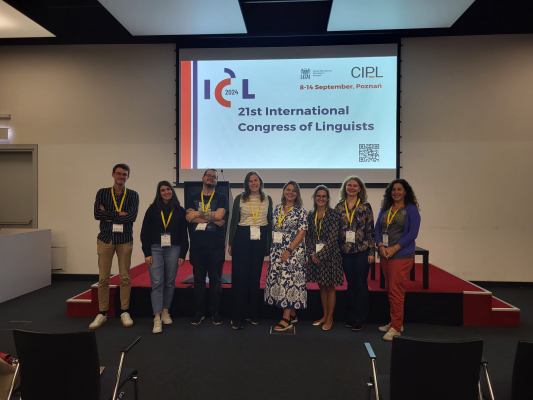Aslı Özyürek and Beyza Sümer at ICL 2024

Aslı Özyürek hosts Multimodal Language, Grammar, and Diversity Session at the 21st International Congress of Linguists (ICL).
The session titled "Multimodal Language, Grammar, and Diversity," convened by Aslı Özyürek from the Max Planck Institute in Nijmegen, was an insightful exploration of how human communication extends beyond speech, incorporating gestures and sign languages. Researchers presented diverse studies that explored the interplay between spoken languages and multimodal elements like gestures and sign languages, broadening our understanding of linguistic diversity.
The session featured a range of fascinating presentations:
-
Aslı Özyürek opened with an introduction, setting the stage for discussions on multimodal communication and its impact on linguistic structures across languages.
-
Chersoni and Lahaussois presented on "Multimodal Clarification Potential," examining how multimodal signals help resolve ambiguities in communication.
-
Sybil Vachaudez, Roland Pfau, and Beyza Sümer shared insights on "Thoughts vs. Actions: Particle Choice in Adamorobe Sign Language Negation," a study that looked at how negation is conveyed through gestures and sign language.
-
Sébastien Vandenitte compared "Multimodal Enactment in LSFB (French Belgian Sign Language) and Belgian French," analyzing how gestures play a role in constructing meaning across different languages.
-
Tomasz Dyrmo explored "Levels of Metaphor in Gesture," investigating how gestures can convey complex metaphorical ideas alongside spoken language.
-
Agata Dymarska focused on "Semantic Effects in Word Processing in Speakers of English as a Second Language," revealing how gestures support second language learning.
-
Theresa Matzinger and her team presented an exciting analysis of "Non-verbal Alignment and Cooperativeness in a Game Theory-Based TV Show," where they examined how non-verbal cues impact team dynamics.
-
Odysseas Asithianakis and Beyza Sümer discussed "The Gestural Other: Accentedness, Gesture Space Use, and Perception of Identity," focusing on how gestures influence perceptions of identity in communication.
-
Andrea Ariño-Bizarro, Aslı Özyürek, and Iraide Ibarretxe-Antuñano offered insights into "Decoding Causal Events: Spanish Gestural Patterns," shedding light on how Spanish speakers use gestures to convey causal relationships.
-
Anna Wilson and her colleagues compared how different languages, including English, Russian, and Georgian, conceptualize the future through both speech and co-speech hand gestures in their work on "Comparative Analysis of Future Conceptualisations."
This session highlighted the rich diversity of multimodal language use across different linguistic communities, both spoken and signed. As the field continues to expand, it is clear that gestures, alongside speech, are central to understanding the full spectrum of human communication.
The "Multimodal Language, Grammar, and Diversity" session was a great success, demonstrating the growing recognition of how visual modalities shape language structures and contribute to cross-linguistic diversity.
Share this page